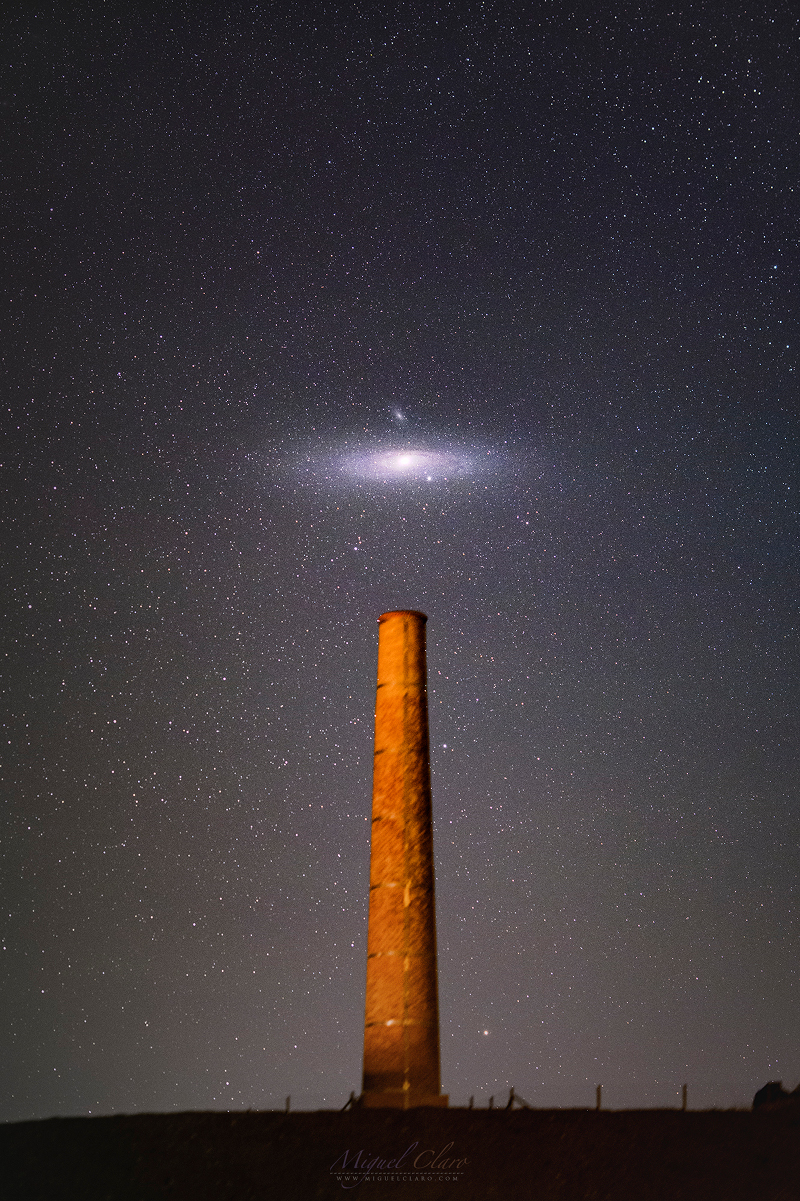25. June 2021
孤張感光 ê 仙女座星系

探索宇宙1!逐工會揀一幅無仝款 ê 影像抑是相片,𤆬你熟似咱這个迷人 ê 宇宙,閣有專業天文學者2為你3解說4。
- 原始文章:Andromdeda in a Single Shot
- 影像來源 kah 版權:Miguel Claro (TWAN, Dark Sky Alqueva)
- 台文翻譯:An-Li Tsai (NCU)
[漢羅] 孤張感光 ê 仙女座星系
你會當看偌遠? 離咱有 250 萬光年遠 ê 仙女座星系,是咱直接用目睭 to̍h 看會著 ê 上遠 ê 天體。 夜空內底其他 ê 住民,親像是恆星、星團、星雲,差不多幾若百抑是幾若千光年遠爾爾。 Tùi 太陽系來講 in 已經有夠遠矣,毋閣 in 猶 tī 咱 ê 銀河系 內底。 仙女座星系又閣叫做 M31,是 銀河外 ê 星系。 這張精心設計 ê 深空夜景,是 tī 葡萄牙南部一个老礦場,M31 to̍h tī 煙筒管 ê 頭殼頂。 這个影像是追蹤天景 ê 孤張感光,所以前景才會因為 kha-mé-lah ê 振動煞小可仔霧霧。 毋閣 仙女座星系看起來是有夠大。 這个星系較光 ê 中心區,一般來講用目睭是攏看有。 外沿 ê 捲螺仔手骨 to̍h 較暗,tī 天頂 ê 大細差不多有 4 粒月圓遐爾闊。 是講時間差不多賰 50 億年左右爾爾,仙女座星系 kah 銀河系 to̍h 會合併。 到時仙女座星系內底 ê 恆星 to̍h 會湠到咱 規个夜空。
[POJ] Ko͘-tiuⁿ kám-kng ê Sian-lú-chō seng-hē
Lí ē-tàng khòaⁿ gōa hn̄g? Lî lán ū nn̄g-pah-gō͘-cha̍p-bān kng-nî hn̄g ê Sian-lú-chō seng-hē, sī lán ti̍t-chiap iōng ba̍k-chiu to̍h khòaⁿ-ē-tio̍h ê siōng-hn̄g ê thian-thé. Iā-khong lāi-té kî-tha ê chū-bîn, chhiⁿ-chhiūⁿ sī hêng-chhiⁿ, seng-thoân, seng-hûn, chha-put-to kúi-ā-pah iah-sī kúi-ā-chheng kng-nî hn̄g niā-niā. Tùi Thài-iông-hē lâi-kóng in í-keng ū-kàu hn̄g ah, m̄-koh in iáu tī lán ê Gîn-hô-hē lāi-té. Sian-lú-chō seng-hē iū-koh kiò-chò M-saⁿ-cha̍p-it, sī Gîn-hô-hē gōa ê seng-hē. Chit-tiuⁿ cheng-sim siat-kè ê chhim-khong iā-kéng, sī tī Phô-tô-gâ lâm-pō͘ chi̍t-ê lāu khòng-tiûⁿ, M-saⁿ-cha̍p-it to̍h tī ian-tâng-kóng ê thâu-khak-téng. Chit-ê iáⁿ-siōng sī tui-chong thian-kéng ê ko͘-tiuⁿ kám-kng, só͘-í chiân-kéng chiah-ē in-ūi kha-mé-lah ê tín-tāng soah sió-khóa-á bū-bū. M̄-koh Sian-lú-chō seng-hē khòaⁿ--khí-lâi sī ū khah-tōa. Chit-ê seng-hē khah-kng ê tiong-sim-khu, it-poaⁿ-lâi-kóng iōng ba̍k-chiu sī lóng khòaⁿ-ū. Gōa-iân ê kńg-lê-á chhiú-kut to̍h khah-àm, tī thiⁿ-téng ê tōa-sè chha-put-to ū 4 lia̍p goe̍h-îⁿ hiah-nī khoah. Sī-kóng sî-kan chha-put-to chhun gō͘-cha̍p-ek nî chó-iū niā-niā, Sian-lú-chō seng-hē kah Gîn-hô-hē to̍h ē ha̍p-pèng. Kàu-sî Sian-lú-chō seng-hē lāi-té ê hêng-chhiⁿ to̍h ē thòaⁿ-kàu lán kui-ê iā-khong.
[KIP] Koo-tiunn kám-kng ê Sian-lú-tsō sing-hē
Lí ē-tàng khuànn guā hn̄g? Lî lán ū nn̄g-pah-gōo-tsa̍p-bān kng-nî hn̄g ê Sian-lú-tsō sing-hē, sī lán ti̍t-tsiap iōng ba̍k-tsiu to̍h khuànn-ē-tio̍h ê siōng-hn̄g ê thian-thé. Iā-khong lāi-té kî-tha ê tsū-bîn, tshinn-tshiūnn sī hîng-tshinn, sing-thuân, sing-hûn, tsha-put-to kuí-ā-pah iah-sī kuí-ā-tshing kng-nî hn̄g niā-niā. Tuì Thài-iông-hē lâi-kóng in í-king ū-kàu hn̄g ah, m̄-koh in iáu tī lán ê Gîn-hô-hē lāi-té. Sian-lú-tsō sing-hē iū-koh kiò-tsò M-sann-tsa̍p-it, sī Gîn-hô-hē guā ê sing-hē. Tsit-tiunn tsing-sim siat-kè ê tshim-khong iā-kíng, sī tī Phô-tô-gâ lâm-pōo tsi̍t-ê lāu khòng-tiûnn, M-sann-tsa̍p-it to̍h tī ian-tâng-kóng ê thâu-khak-tíng. Tsit-ê iánn-siōng sī tui-tsong thian-kíng ê koo-tiunn kám-kng, sóo-í tsiân-kíng tsiah-ē in-uī kha-mé-lah ê tín-tāng suah sió-khuá-á bū-bū. M̄-koh Sian-lú-tsō sing-hē khuànn-khí-lâi sī ū khah-tuā. Tsit-ê sing-hē khah-kng ê tiong-sim-khu, it-puann-lâi-kóng iōng ba̍k-tsiu sī lóng khuànn-ū. Guā-iân ê kńg-lê-á tshiú-kut to̍h khah-àm, tī thinn-tíng ê tuā-sè tsha-put-to ū 4 lia̍p gue̍h-înn hiah-nī khuah. Sī-kóng sî-kan tsha-put-to tshun gōo-tsa̍p-ik nî tsó-iū niā-niā, Sian-lú-tsō sing-hē kah Gîn-hô-hē to̍h ē ha̍p-pìng. Kàu-sî Sian-lú-tsō sing-hē lāi-té ê hîng-tshinn to̍h ē thuànn-kàu lán kui-ê iā-khong.
[English] Andromdeda in a Single Shot
How far can you see? The Andromeda Galaxy, 2.5 million light years away, is the most distant object easily seen by the unaided eye. Other denizens of the night sky, like stars, clusters, and nebulae, are typically hundreds to thousands of light-years distant. That's far beyond the Solar System but well within our own Milky Way Galaxy. Also known as M31, the external galaxy poses directly above a chimney in this well-planned deep night skyscape from an old mine in southern Portugal. The image was captured in a single exposure tracking the sky, so the foreground is slightly blurred by the camera's motion while Andromeda itself looms large. The galaxy's brighter central region, normally all that's visible to the naked-eye, can be seen extending to spiral arms with fainter outer reaches spanning over 4 full moons across the sky. Of course in only 5 billion years or so, the stars of Andromeda could span the entire night sky as the Andromeda Galaxy merges with the Milky Way.
詞彙學習
| 漢羅 | POJ | KIP | 華語 | English |
|---|---|---|---|---|
| 仙女座星系 | Sian-lú-chō seng-hē | Sian-lú-tsō sing-hē | 仙女座星系 | the Andromeda Galaxy |
| 捲螺仔手骨 | kńg-lê-á chhiú-kut | kńg-lê-á tshiú-kut | 螺旋手臂、旋臂 | spiral arm |
| 太陽系 | Thài-iông-hē | Thài-iông-hē | 太陽系 | the Solar System |
| 銀河系 | Gîn-hô-hē | Gîn-hô-hē | 銀河系 | the Milky Way |